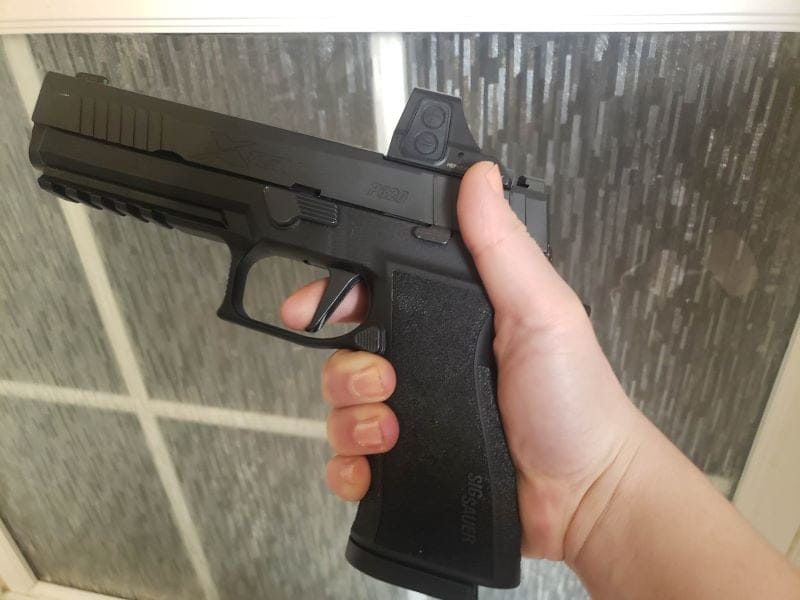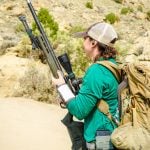The trigger is a foundational part of a firearm, both in ARs and pistols. A good trigger that has a clean break, easy press, and adheres to your comfort will affect how well you shoot that firearm. That’s just the thing though, it is how well YOU shoot it. Triggers are such a preference thing. One person may like something over another person—single stage over two-stage triggers, heavier over lighter triggers dependent on discipline, and even, flat over a curved trigger.
The preference for a flat trigger does have merit in certain environments. There are so many different triggers on the market, though, that it is important to know why one may choose a flat trigger over anything else. Or, why one may go a different route.
Types of Trigger Levers
Before going any further, let’s go over some terms. In this article, we will not be talking about the entire trigger, but rather the trigger lever or trigger shoe.
The trigger lever is the part of the trigger that the finger makes contact with and physically presses to the rear. This will sometimes be called a trigger blade as well.
A trigger shoe is a little different. This is a piece that actually fits over the current trigger, often by two set screws. Sometimes these can get a little mixed up by both companies and users, as there are some trigger shoes on the market that actually replace the entire trigger lever. A trigger pad can often bring up results of the same type of piece.
Flat/Straight
A flat trigger lever, sometimes referred to as a straight trigger, is a non-curved trigger. These will often be an upgrade to a pistol such as in the Legion Series of Sig Sauer pistols, these have a flat trigger. Many aftermarket Glock Triggers are flat as well.
Curved and Pro Curved
A curved trigger lever is your standard curved trigger. These usually come standard in guns. However there are now triggers on the market that are curved, but not as sharply. The curve truly depends on the company. With Triggertech, the Pro Curve has a traditional curve but more surface area. Others such as Timney Triggers have a flatter curve.
FingerPad
Hiperfire triggers offer a competition trigger with a HiperShoe Finger Pad. This pad can be adjusted to user preference allowing the placement of the finger to be the same each time. Other companies are also coming out with trigger pads creating a wider surface area and flatter surface than a standard shoe.

Preferences and Benefits
Trigger preference relates to the specific gun being used and the discipline in which it is being used. These benefits may or may not work for you in some instances and guns. Take all of these benefits with a grain of salt.
The video below from Vortex Nation explains why a flat trigger may work in some disciplines and some guns and not in others.
Finger Placement
A flat trigger allows for a lot more leeway into where you place your finger since a curve doesn’t stop your placement. Some say that this can help to be faster in finding the trigger and pressing the trigger. This is why a lot of competition guns will have a straight trigger in them.
Depending on the gun, flat triggers also often have more surface area and width to them, allowing you to get more of the meat of your finger into pressing the trigger.
Weight of the Press
Leverage is something that is involved when it comes to triggers. Using a torque wrench as an example, when attachments are added to a torque wrench, that leverage/weight of the torque wrench is actually higher due to having more leverage/distance away from the thing being torqued. That is why there is a whole math equation for what your torque setting is when attachments are added.
Same as a breaker bar. The longer the bar, the more leverage you have.
Back to triggers. The further to the top of a trigger lever that you go, the more weight will be needed. The lower or closer to the end of a trigger, the less weight will be needed to break the trigger. Some state that a flat trigger is nice in pistols but also in rifles as well because the bottom of the trigger can be pressed, thus allowing a lighter trigger press. When shooting rifles, many want a very light and short press to take a well-aimed slow shot and a flat trigger that allows the finger to be placed anywhere on the trigger. This, as opposed to a curved trigger that may dictate where the finger is placed, may be a better option.

A flat trigger may not be a benefit for those with small hands.
While many think that flat triggers or curved triggers in a pistol may help users with smaller hands, the shape of the lever may not be as important as the grip of the pistol itself. Small-handed users will often want a trigger that is closer to the rear of the gun and lighter so that not as much finger reach is needed to press it straight to the rear. Just because a trigger is flat does not mean that it will be lighter or closer to the rear. It is 100% dependent on the manufacturer of the trigger and the grip of the pistol.
Being a small-handed person myself, I have had curved triggers in pistols, such as in the Walther PDP, that my finger reached and pressed with ease. Probably the best pistol that I shoot, honestly. Then, I bought the Sig P320-XTEN that has a legion flat trigger inside of it, and I can also reach and press that with ease due to the upgraded grip.
This works the other way as well, as with a lot of Glocks with factory curved triggers, I have a hard time reaching the trigger. The point is, a flat trigger might not be of help to a user with small hands, just because it is flat. Look at the weight of the trigger and decide what is both an effective weight and safe weight of that trigger for the user. Then, research that trigger along with “small hands.” A review or blog post on it may pop up.

Options to Purchase
Below are some triggers available for purchase from various companies. It is worth noting that the angle of the trigger lever may not be as important as the type of company it is coming from. There are competition-forward companies such as Hiperfire, recreational companies such as Timney, or precision companies such as Triggertech. This may help with finding the right type of trigger lever along with the weight of the trigger for your specific discipline.
Pistol and Carbine
When it comes to shooting fast in competition, many flock to flat triggers in their competition guns. Some like it only in their competition pistols, and some like flat triggers in both their competition pistol and carbine.
Timney Competition AR-15 Straight Trigger
Price: $224.99 – $279.99

ZEV Technologies Flat Faced Trigger
Price: $132.99

Precision Rifle
In precision rifle, many users still like curved triggers. However, many are flocking towards something along the lines of a Triggertech pro curve which is still a curved trigger but with added surface area. Just as those who prefer flat triggers state, users who like the pro curve also say that this curve helps with keeping consistent finger placement on the trigger. Again, it all boils down to preference.
Triggertech does offer flat options as well, even for bolt guns.
TriggerTech Rem 700 Diamond Trigger (Flat Straight)
Price: 304.99

You Do You
While there are advantages to both a flat and curved trigger, these advantages vary from person to person. As always, take recommendations with a grain of salt and do what works well for you after you have tried different methods.


